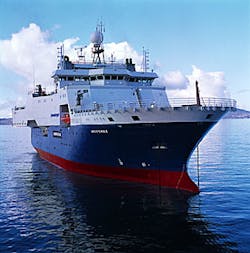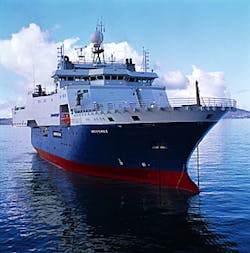High volume, low unit cost pursuit driven by commodity pricing
Data, collaboration, telecommunications changes sweeping industry
Victor Schmidt
Exploration Editor
High capacity critical path systems like the Transocean Dicoverer Enterprise and Geco Eagle use parallel operations to maintain the industry's competitive advantage.
- The historic price of a bbl of oil has had a downward trend throughout its history. Prices have followed a similar but steeper trend since the 1970s oil price shocks. [9,067 bytes]
- Transocean Dicoverer Enterprise [42,612 bytes]
The trend to higher efficiency and higher productivity has now traveled the length of the upstream business, from field operations up the product chain to the very front-end of the business - seismic acquisition. A recent example of this trend is the new class of seismic vessels that combine high capacity, high productivity, large internal processing capability, immediate feedback, and automatic adjustment.
This data-collaboration-telecommunications megatrend is emerging in every sector of the petroleum business. Low commodity pricing for oil is the primary driver. The event has forced oil to follow the decreasing price trend common to all commodity businesses. Individual companies must either become efficient or combine to gain economies of scale. It is the only way to maintain profitability.
Commodity businesses
The oil business is following the path of many other commodity-based businesses. Let us examine three: agriculture, fishing and money.- Agriculture: At the end of the 19th century, the family farm ruled. Most people grew their food, sold some, raised animals to service their needs, and used horses to extend the efficiency of the farmer. First, steam power, then diesel power, replaced the horse and brought new levels of efficiency.
The result, it took fewer farmers to cultivate the same acreage, but they produced even larger crops. What has evolved from this mechanized efficiency is - agribusiness. In the US, about 4% of the population is engaged in cultivating the land, yet the output is so large, much of it is export to other countries. The surplus has kept prices low (high volume, low unit cost).
- Fishing: Dropping a line in the water is and has been a way of life for many coastal populations around the world. Nets were used and increased the catch. When steam and internal combustion engines were developed, the fishing vessels and nets became larger. Soon fishermen formed cooperative arrangements.
That reorganization culminated in huge factory ships that sweep the seas. They are self-contained cities that stay at sea for months at a time filling their holds with the catch. The vessels are so efficient at gathering fish that international treaties are now necessary to control their use and prevent excessive harvesting. But, seafood prices remain relatively low in most countries (high volume, low unit cost).
- Money: The US's Wall St., and its counterpart exchanges around the world, used to operate at a leisurely pace. Money was an upper-class, gentlemanly pursuit. As the world industrialized early in this century, the need for capital expanded. Bankers sought to expand accounts and find efficient ways to utilize the deposits. Of course, workers demanded something for the use of their hard-earned cash - interest or dividends.
Now, money flows 24 hours a day, seven days each week. There are "war rooms" where traders operate constantly, monitoring information flows from transactions around the world. As one market closes, another opens. The traders route accounts, investments, and money flows to the most productive uses available. Costs of capital are matched to risk (high volume, low unit cost).
High volume, low unit cost
Similar moves to efficiency are evident in the oil business. Until the 1970s, the price of oil was reasonably stable, but with an overall downward trend. The 1973 and 1979 oil price increases only arrested the general downward trend for 25 years. So, both the history and future of a commodity business, such as oil and gas, are one and the same - high volume, low unit cost - to match the most efficient market price.The petroleum business has always encouraged the development of new technology, more efficient tools, and more effective processes. Industry inventors have made careers and lots of money with new approaches. The cash flow peaks and valleys of the past 20 years spurred the most recent application of these ideas and approaches. They are culminating in mechanical efficiency, material flow efficiency, and (most important of all) information flow efficiency.
- Wellbore: Beginning at the wellbore, downhole tools and bits improved so that holes were cut better. Polycrystalline bits replaced roller cones just as roller cones replaced fishtail bits. Logging tools, instead of being run singly, were first piggybacked on a single tool. Later they were run in tandem, then in triples. Pipe strings were once set all the way from the bottom hole position to the surface. Now they are staged or even tapered as they run to bottom.
- Drilling rigs: Cable-tool steam rigs gave way to rotary diesel rigs. Racking pipe and slinging chain was the way it was done, until the newest generation of drilling equipment entered the fleet. Now a single operator controls the drilling operation. Pipe strings are made-up mechanically and "fed" into the hole as needed. For some operations, coiled tubing is used, completely eliminating pipe make-up. The labor-intensive processes of the earlier era have been mechanized out of existence. The new rigs are more efficient, safer, and more costly upfront, but overall a better value for the work done.
- Platform design: The move to efficiency is even seen in the structures used to extract, condition, and produce the oil flow. Massive steel and concrete structures used to develop fields are being replaced by lighter, automated production facilities. Networks of control umbilicals now allow field operations to be centralized. Data flows along with oil, both ways, to fully monitor and regulate the production from active wells.
- Seismic vessels: It has always been easier to modify hardware and shape new equipment than it has been to produce prospects to drill. In large measure, it is due to dispersed information that must be gathered, transferred to maps, and developed into prospects. Paper maps, ink and colored pencils ruled for over a century as the primary tools of geoscientists and reservoir engineers. That changed with the development of first the scientific calculator, then personal computer in the late 1970s. A paradigm shift to the computer workstation ensued and is now being overtaken by the virtual reality room. This is where a team of geoscience and engineering experts can pool their collective wisdom to discern the intricacies of the earth. The tool of choice for these experts is the seismic data cube. Once painstakenly gathered by two or more vessels working together, the new high capacity vessels working alone today can collect huge dense data sets. Fewer towing platforms, more streamers, onboard supercomputers, and high-capacity telecommunications all combine to sweep the seas in search of oil reservoirs.
Future directions
So, where is this industry megatrend headed? Just as other commodity businesses, the petroleum industry will continue to strive for even greater efficiencies. The industry has come a long way, but the future holds an even more intensive data world. Data density and data handling will outstrip anything being done today. The industry will create autonomous equipment to do the most dangerous and difficult work. The combination will become an organic whole, with much smoother transitions between its operating elements.The project critical path will rule - maximum output in minimum time. Operations will be fully planned in advance and orchestrated to use each element most effectively and efficiently. Much of the routine work will be given to artificially intelligent agents. Much like the "daemons" that fetch information on the world wide web, specialized programs running on silicon-based systems will free professionals and workers from many routine tasks of normal operations. Thinking and problem-solving skills will be used more productively. The trend can be extrapolated to every industry specialty.
For example, sometime in the future a group of professionals will meet to monitor the operations of 10 wells that are being drilled in various parts of the world. They will meet in a space where each can see the other, communicate readily, can see the wells and all the information flowing from the 10 separate operations. Traditional weight-on-bit, mud chemistry, and other data are shown and manipulated, but also the well progress through the enhanced earth model along the projected path.
Also shown for the group are updates from the logging tools immediately behind the bit, as well as updates to the projected reserves-in-place and extraction cashflow model of the oilfield to be. Oh, did I mention that the experts would be in separate parts of the world, but meet in a "virtual reality space.
"Link that image to a similar one following the gathering and interpretation of seismic infor mation. Link it to a fabrication facility, which will build the needed production structures. Link it to the downstream function that will take the oilflow and service the worldwide market. That is where we are heading.
The element of risk will be transformed and new and different skills will be required. This networked operation with teams of experts will monitor and operate multiple projects around the world 24 hours a day, seven days a week, because that is the way to boost volume and lower unit prices.
Copyright 1999 Oil & Gas Journal. All Rights Reserved.

